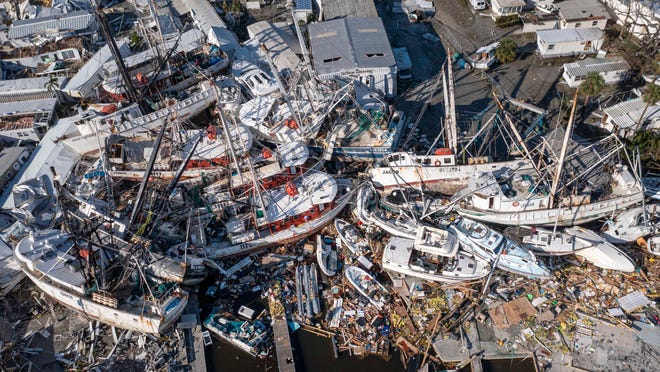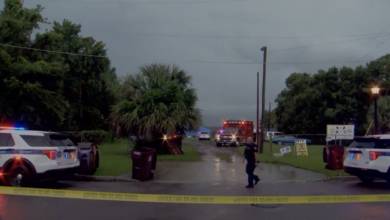
Hurricane Ian's U.S. death toll rose to 27 as the storm, now a post-tropical cyclone, churned northward Saturday across central North Carolina after hammering the coast of South Carolina and devastating swaths of Florida.
Power was knocked out for over 300,000 customers in North Carolina and almost 100,000 in Virginia as of Saturday morning, according to poweroutage.us.
In South Carolina, almost 60,000 people were still without power after Ian toppled trees and flooded roadways.
Meanwhile, over 1.2 million people remained without power in Florida as officials assessed the damage and continued search and rescue efforts. The storm left a broad trail of destruction in the state, flooding areas on both of its coasts, tearing homes from their slabs and demolishing beachfront businesses.
President Joe Biden said Friday that Hurricane Ian is “likely to rank among the worst in the nation’s history” and Florida will take “months – years – to rebuild.”
GET TEXT UPDATES:Sign up here for text updates on Ian.

Latest developments:
►In South Carolina near Myrtle Beach, the end of the Pawleys Island pier collapsed and was floating as Ian made landfall, according to a Twitter post from the Pawleys Island Police Department.
► Florida's Volusia County Community Information Director Kevin Captain said at a news conference Friday afternoon that the Daytona International Speedway was flooded by Hurricane Ian. "Even our iconic speedway is underwater," he said.
►Cubans protested for a second night Friday over delays in restoring electricity to the country after Hurricane Ian knocked out power across the island.
Heavy rain hits central Appalachians, mid-Atlantic
Heavy rains were forecast Saturday morning for the central Appalachians and mid-Atlantic as Ian trekked across central North Carolina and toward Virginia, according to the National Hurricane Center. The storm is expected to weaken and dissipate over south-central Virginia by Saturday night.
But until then, Ian will bring gusty winds and drop 2 to 4 inches of rain with local maximums of 6 inches onto the central Appalachians and coastal mid-Atlantic, which may see limited flash and urban flooding.
Major river flooding is expected in parts of central Florida into next week, but swells seen in the Southeast should subside over the weekend.
'BABY, IT'S TIME TO GO':First-time Florida mom gives birth in midst of Ian's wrath

A PATH OF DESTRUCTION:Photos show Hurricane Ian's damage in Cuba, Florida, Carolinas
Death toll likely to grow in Florida
The destruction left behind by Ian has made it difficult to quickly know how many had perished in the storm, but the death count has climbed to 27, the Associated Press said Friday night.
On Friday morning, Florida Emergency Management Director Kevin Guthrie said there were as many as 21 deaths, but only one had been confirmed as the result of the storm, while officials were evaluating 20 other deaths.
Among the newly reported deaths were a 62-year-old woman who was injured and drowned after a tree fell on a mobile home, a 54-year-old man found trapped in a window after drowning and a woman tangled in wires in Florida's Lee County.
Before hitting Florida, Ian also swept through Cuba earlier this week, killing three people.
Post-Tropical Cyclone Ian tracker
After slowly moving across Florida, Ian gained new strength over the Atlantic Ocean on Thursday before wreaking havoc on South Carolina, Georgia and more states along the East Coast.
It weakened to a post-tropical cyclone Friday afternoon, and by 5 a.m. Saturday, it was located 30 miles south of Greensboro, North Carolina, and was moving north at 12 mph with maximum sustained winds of 35 mph, the hurricane center said.
Check here for the latest updates on the storm's strength and track where it's headed next.
Floridians escape Ian:They found refuge – and slot machines at a casino
Inland Florida choked by river flooding
Rising waters continue to wreak havoc in Florida, where river flooding persists long after winds have passed.
As heavy rains flow into suburban and inland areas, continued river flooding shows how Ian's impacts have stretched far beyond Florida's beaches and coastal towns.
The rising waters have turned roads into canals, flooded vehicles and trapped families in waterlogged homes. In North Port, a Sarasota suburb, residents are beginning to run out of food and water.
"Water just keeps going up," said Samuel Almanzar, 42. "Who knows when it is going to stop."
Local officials have said some areas will see rising water levels over the next two days and encouraged residents of flooded neighborhoods to evacuate.
Crews from 30 states rush to restore power in Florida
Of its 2.1 million customers who lost power after Hurricane Ian, Florida Power & Light, a utility that serves about half of Floridians, has restored electricity to two-thirds of them, or 1.4 million customers, Bryan Garner, a spokesperson for the company, told USA TODAY on Saturday.
Crews of about 21,000 people, including those providing aid from 30 states, are working to restore electricity to remaining customers, most of whom can expect power by next week. Garner said FPL will have clearer timelines for hardest-hit communities by Saturday night.
"In those hardest hit areas, there's likely such catastrophic damage that, even if we get the grid repaired, there will be homes and businesses that will not be able to receive power," he said. "For some homes and businesses, something may have to be rebuilt and electricians may have to come in, so they may be out for an extended period of time."
Flooding expected but still 'heartbreaking'
As Ian drenched some areas with up to 17 inches of rain, floodwaters spilled out of scenic lakes, ponds and rivers and into homes, forcing emergency evacuations and rescues.
Researchers who study flooding, development and climate change were horrified by the emerging images but not surprised. For years, they’ve warned sprawling development in Florida and other coastal states isn’t sustainable, especially with the warming climate supercharging hurricane rainfall.
"This is kind of what we had expected for days in advance, and it's still heartbreaking to see so many people stranded," said Kevin Reed, associate professor in atmospheric science at Stony Brook University in New York.
He and other experts said they expect Ian's devastation to lead to a push for Florida to do more to protect residents from future flooding as the warming climate makes natural disasters and rainfall more extreme.
— Dinah Voyles Pulver, USA TODAY
At least 25 dead in Puerto Rico after Hurricane Fiona
Less than two weeks after Hurricane Fiona devastated Puerto Rico and plunged the island into darkness, the country's health department announced that at least 25 people have died from the storm.
The deaths may be either directly or indirectly related to the hurricane, the department said.
Eighteen of the deaths were people over 65, while 15 were men while 10 were women.
Contributing: John Bacon, Thao Nguyen, Jorge Ortiz, Doyle Rice, Jeanine Santucci, USA TODAY; The Associated Press







